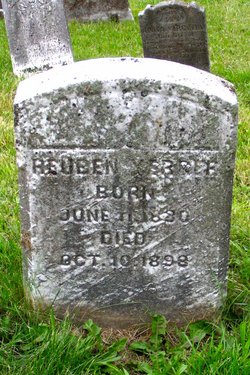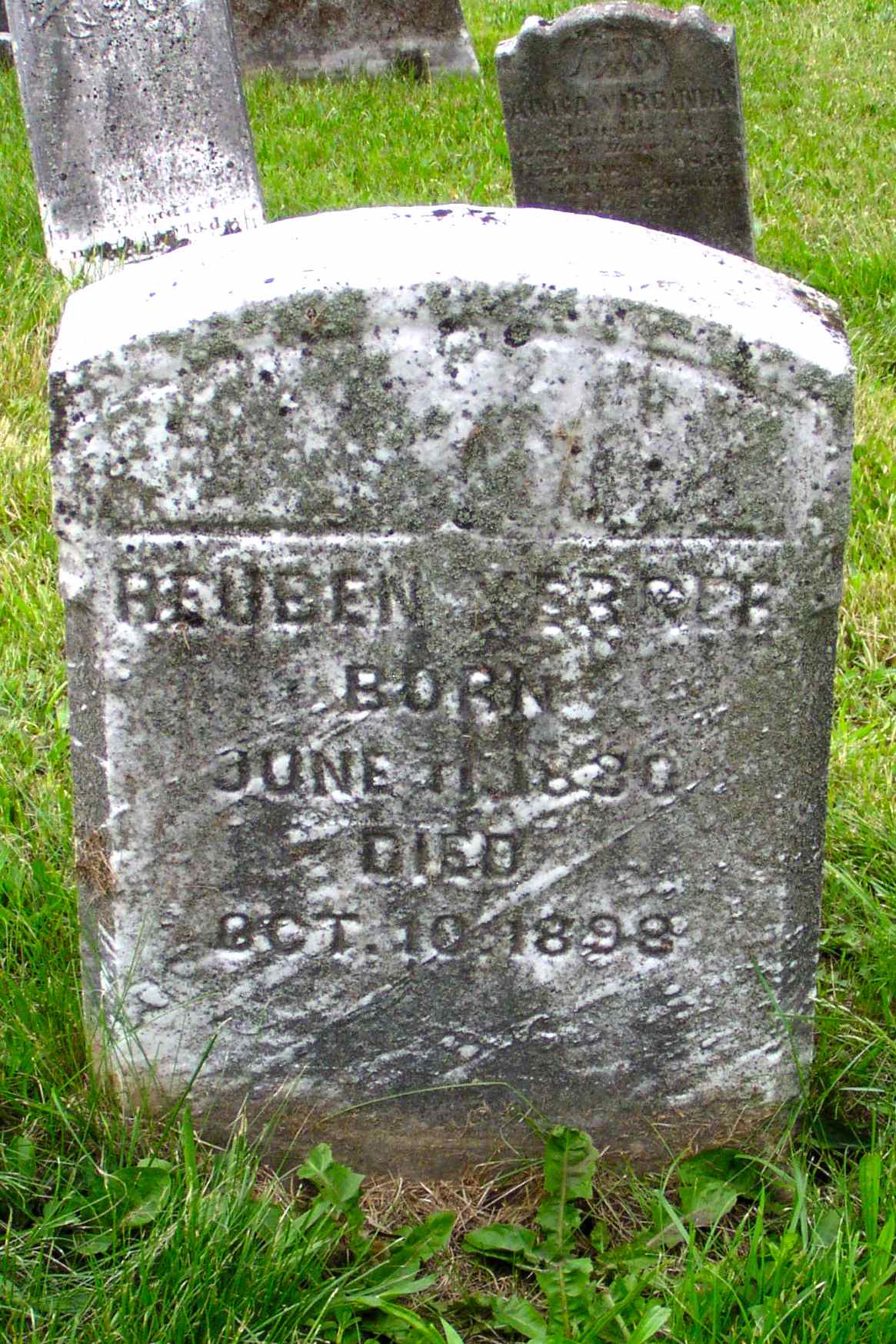Enlisted from Greensburg, Westmoreland County, Pennsylvania and mustered in on 20 September 1861, Company I, 11th Pennsylvania Volunteer Infantry Regiment as a Private; wounded in action during the engagement at Rappahannock Station, Virginia on 21 August 1862; wounded in action, again, on 30 August 1892 during the 2nd Battle of Bull Run, Virginia; wounded a third time during the battle of Antietam, Maryland; mustered out on 27 April 1863.
"Case 148. — Private R. Yerger, Co. I, 11th Pennsylvania, aged 31 years, was wounded at Antietam, September 17, 1862, and entered the Broad and Cherry Streets Hospital, Philadelphia, on December 12th. Surgeon J. Neill, U. S. V., reported: "He was admitted to this hospital with an undetected fracture of the neck of the right femur. A minie ball entered on the front of the thigh on a vertical line with the anterior superior spinous process of the ilium and four inches below it, and, passing obliquely upward and backward, was cut out on a line with and about two inches below the posterior superior spinous process by the surgeon of the regiment on the field. At the time of his admission the wound had entirely healed, but the patient was unable to bear weight on the limb without pain. The tissues over and above the trochanter were flattened, and the fold in the buttock was absent. Rotation was imperfect, and when an attempt was made to bear weight on the limb distinct crepitus could be felt in the neck of the bone, and he complained of pain at that point. Measurement from the xiphoid cartilage revealed two and a half inches shortening of the injured side, and from the anterior superior spinous process of the ilium it was three-fourths of an inch. The fracture appeared to be impacted, and the whole of the right innominate bone was considerably elevated above its normal position. The posterior superior spinous process of that side was also more prominent than that on the other side, giving the idea that the sacro-iliac symphysis had been injured and in that way accounting for the marked amount of shortening by measurement from the xiphoid cartilage. He stated that when shot he fell, the right hip striking the ground, and any attempt to move the limb gave rise to severe pain in the hip joint; also that the surgeon told him it was only a flesh wound and would soon be well. He remained in a field hospital for nine days, when he was removed to Chambersburg and treated for nine weeks, during which time he was allowed to get up to go to stool. The wound healed about two weeks before admission to this hospital. No fragments of bone were removed; crepitis is not so distinct, and his general condition is good. The amount of shortening from the anterior superior spinous process has increased from three-fourths to a full inch since admission." The patient was discharged from service April 27, 1863, and pensioned. Examiner J. J. McCormick, of Irwin Station, Pennsylvania, certified, Septembers, 1873: '"Ball entered right thigh in front of trochanter major and came out one inch from lower end of sacrum, fracturing the neck of the femur. The limb is two and one-half inches shorter than the other; strength so much impaired that he cannot walk without a cane. Muscles of limb are atrophied." In an examination for increase of pension, in April, 1880, Examiner McCormick reports: "There is great impairment of the strength and usefulness of the limb. The pensioner cannot work at all, nor can he set on a chair except a little on the left hip. The injury is nearly equivalent to the loss of the limb." -- The Medical and Surgical History of the War of the Rebellion. Part III, Volume II. (3rd Surgical volume) by U. S. Army Surgeon General's Office, 1883.
Enlisted from Greensburg, Westmoreland County, Pennsylvania and mustered in on 20 September 1861, Company I, 11th Pennsylvania Volunteer Infantry Regiment as a Private; wounded in action during the engagement at Rappahannock Station, Virginia on 21 August 1862; wounded in action, again, on 30 August 1892 during the 2nd Battle of Bull Run, Virginia; wounded a third time during the battle of Antietam, Maryland; mustered out on 27 April 1863.
"Case 148. — Private R. Yerger, Co. I, 11th Pennsylvania, aged 31 years, was wounded at Antietam, September 17, 1862, and entered the Broad and Cherry Streets Hospital, Philadelphia, on December 12th. Surgeon J. Neill, U. S. V., reported: "He was admitted to this hospital with an undetected fracture of the neck of the right femur. A minie ball entered on the front of the thigh on a vertical line with the anterior superior spinous process of the ilium and four inches below it, and, passing obliquely upward and backward, was cut out on a line with and about two inches below the posterior superior spinous process by the surgeon of the regiment on the field. At the time of his admission the wound had entirely healed, but the patient was unable to bear weight on the limb without pain. The tissues over and above the trochanter were flattened, and the fold in the buttock was absent. Rotation was imperfect, and when an attempt was made to bear weight on the limb distinct crepitus could be felt in the neck of the bone, and he complained of pain at that point. Measurement from the xiphoid cartilage revealed two and a half inches shortening of the injured side, and from the anterior superior spinous process of the ilium it was three-fourths of an inch. The fracture appeared to be impacted, and the whole of the right innominate bone was considerably elevated above its normal position. The posterior superior spinous process of that side was also more prominent than that on the other side, giving the idea that the sacro-iliac symphysis had been injured and in that way accounting for the marked amount of shortening by measurement from the xiphoid cartilage. He stated that when shot he fell, the right hip striking the ground, and any attempt to move the limb gave rise to severe pain in the hip joint; also that the surgeon told him it was only a flesh wound and would soon be well. He remained in a field hospital for nine days, when he was removed to Chambersburg and treated for nine weeks, during which time he was allowed to get up to go to stool. The wound healed about two weeks before admission to this hospital. No fragments of bone were removed; crepitis is not so distinct, and his general condition is good. The amount of shortening from the anterior superior spinous process has increased from three-fourths to a full inch since admission." The patient was discharged from service April 27, 1863, and pensioned. Examiner J. J. McCormick, of Irwin Station, Pennsylvania, certified, Septembers, 1873: '"Ball entered right thigh in front of trochanter major and came out one inch from lower end of sacrum, fracturing the neck of the femur. The limb is two and one-half inches shorter than the other; strength so much impaired that he cannot walk without a cane. Muscles of limb are atrophied." In an examination for increase of pension, in April, 1880, Examiner McCormick reports: "There is great impairment of the strength and usefulness of the limb. The pensioner cannot work at all, nor can he set on a chair except a little on the left hip. The injury is nearly equivalent to the loss of the limb." -- The Medical and Surgical History of the War of the Rebellion. Part III, Volume II. (3rd Surgical volume) by U. S. Army Surgeon General's Office, 1883.
Family Members
Advertisement
Explore more
Sponsored by Ancestry
Advertisement









